- NEW DVD Series – Stone Setting with Bezels
- Tube Set Charm by Kim St. Jean
- Prong Basket Pendant by Kim St. Jean
- NEW DVD Series – Stone Setting with Cold Connections
- New DVD Series – Stone Setting with Wire
- NEW DVD Series: Introduction to Stone Setting by Kim St. Jean
- Featured Tool: Bracelet Bending Plier
- NEW Dvd by Eva Sherman
- Fun, Fast Fold Forming DVD Series
- Double Band Ear Cuff from Alex Simkin
Gem Profile July 9: Fulgurite – A Striking Creation!
by Layna Palmer, Wire-Sculpture.com

Fulgurite
I love a good rain storm, and if you look at the weather reports for this region you already know how badly we need one. I’m not talking about the gentle little pitter-patter rain or the drizzle for day’s type either. I mean a good ol’ booming desert storm that rolls in during the afternoon, dumps copious amounts of water for 20-30 minutes while making all the noise it can, and then just as quickly dissipates leaving everything greener and smelling fresh and new.
I love watching the lightning flash across the sky, hearing the thunder roll and echo as it bounces off the mountains and seeing the rivers of water in the road as the earth soaks up the much-needed moisture.
What is Fulgurite:
I think what gives these storms their impressive noise and power is the lightning that builds and discharges, creating an amazing show of Mother Nature’s might. When lightning strikes the ground, however, it can cause both destruction and also create something amazing as it becomes frozen in the ground as Fulgurite, which is Latin for thunderbolt.
Lightning strikes at a temperature of around 3270 degrees Fahrenheit creating enough heat to instantly transform high silica and quartz soil to glass around the immediate area of the strike. These tubes are smooth on the inside and are surrounded by partially melted and fused soil on the outside. Though not very attractive in an aesthetic definition, they are beautiful nonetheless.
Why is it so unique?
So, is a Fulgurite created every time lightning strikes the ground? The answer would be, probably not. Researchers from the University of Florida Department of Electrical and Computer engineering have been studying the effects of lightning on power lines above and below the ground at their research facility at Camp Blanding near Starke Florida since 1994. Their findings have been that lighting will blow sand up, it will “eat” the soil, and will sometimes form a Fulgurite. They have found that the higher the silica and quartz content of soil and the more densely it is packed, the more likely it is to create a Fulgurite.
Researchers have also found that lightning will strike the ground and then travel to the water table, sometimes branching out under ground for a few feet before it stops. In 1996, they found a very large Fulgurite that has set a world record for its size.
Florida boasts the greatest number of Fulgurite since that state also has some of the highest number of lightning strikes with 10-15 strikes per square kilometer each year. Fulgurites have also been found on the tops of some of the worlds higher mountains like the Alps, Sierra Nevada’s, Cascades, Wasatch and Uinta mountain ranges.
Fulgurites created in nature can range anywhere from a couple of inches to several feet with a thickness from that of a drinking straw to several inches in diameter. You can even create Fulgurite in a lab setting by passing (arcing) electricity through high-silica sand, but these are small, only an inch or two in length.
Wrapping it up.
Now, before you go out in a thunderstorm looking for lightning to strike the ground so you can dig up your own piece of it, remember that not every strike creates a fulgurite and not every soil is ideal for its creation. Lightning also travels at about 140,000 miles per hour and can reach temperatures rivaling that of the surface of the sun. It can also send you back in time…so be careful.
As for me? I’m going to sit back in my air-conditioned home and hope those clouds on the horizon are here to give us some rain, some thunder and maybe a few Fulgurite.
Do you have any beautiful jewelry or gem profile ideas that you’d like to share with us? Send us pictures at tips@wire-sculpture.com and they could be featured!
Resources:
- Florida’s Fantastic Fulgurite Find
- A Complete study of Fulgurite
- Additional data on the creation of Fulgurite
Gem Profile by Layna Palmer
Click to Receive Daily Tips by Email





















0 comments